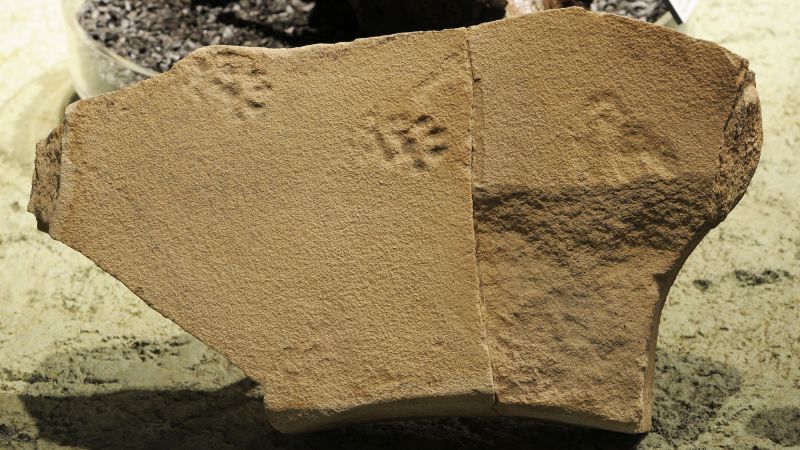The fascinating journey into the realms of prehistory has been illuminated by research recently published in the journal Palaeontologia Electronica. In a remarkable study led by undergraduate intern Conner Bennett at the John Day Fossil Beds National Monument in central Oregon, evidence suggests the existence of ancient avian life and its behaviors, notably the foraging habits of a small bird that once roamed the Eocene Epoch, approximately 50 million years ago. The meticulous work involved analyzing tiny fossil footprints that reveal a story far beyond mere existence, offering insights into the ecological dynamics of prehistoric Oregon.
The Eocene Epoch, known for its rich diversity of life and a critical time in mammalian evolution, provided a unique context for the research. Conner Bennett delved into the park’s archives, where he encountered several sets of fossilized tracks from animals that had been unearthed previously but never studied in detail. Armed with advanced 3D modeling software, Bennett set out to analyze these animal impressions, paving the way for a deeper understanding of the organisms that inhabited the area.
Trace fossils, which include the footprints and markings left by organisms, have garnered less attention compared to more traditional paleontological studies focused on bones and teeth. According to Bennett, “Trace fossils definitely do tell stories,” likening the study of these remnants to chasing the echoes of ghosts. Although the body of the bird itself was never found, the tracks offered a narrative of its actions and behaviors—critical clues to how these creatures interacted with their environment.
Dr. Anthony Martin, a professor of practice in environmental sciences at Emory University, underscored the importance of trace fossils in reconstructing ecosystems. He noted that even without any physical remains, such as bones or feathers, the presence of footprints and tracks indicates the existence of these animals. The unique insights provided by these imprints fill significant gaps in the fossil record, allowing scientists to understand the ecosystem dynamics even in the absence of complete body fossils.
As Bennett explored the fossil tracks, he employed advanced photographic techniques to capture hundreds of overlapping images. This methodology allowed him to construct detailed 3D representations of the footprints. One particular set struck him as resembling a small shorebird, perhaps akin to a modern-day plover. Though no bird fossils had been found at John Day due to their fragile nature, the presence of these tracks suggests that similar species ventured near the lake that once dominated the landscape.
Alongside the bird tracks, Bennett and his coauthor, Dr. Nicholas A. Famoso, uncovered additional marks that led them to consider whether the circumstantial indentations near the footprints were made by the bird’s beak as it searched for food. Observing contemporary plovers engaging in similar behavior provided compelling evidence for their hypothesis that the ancient bird’s foraging habits closely mirrored those of modern species.
The study not only confirmed the former existence of birds near the lake but also provided tangible evidence of their feeding behaviors, a connection that spans across millions of years. Alongside the insights gleaned about avian life, Bennett encountered footprints of a small lizard, revealing yet another piece of the ecological puzzle in Eocene Oregon. The tracks displayed details of the lizard’s movement, showcasing claw-like impressions—further expanding the narrative of life during this dynamic geological epoch.
As the research progressed, Bennett also examined two other trace fossils, leading to the discovery of mammal tracks from a more recent time period. His attention to these remnants, including those attributed to a possible ancient tapir or a saber-toothed cat, underscored the continuous evolution of life in response to changing landscapes.
Dr. Danielle Fraser, a paleobiologist at the Canadian Museum of Nature, expressed great enthusiasm for these findings. She emphasized the significance of the behavioral behaviors captured in trace fossils, which often go unrecognized in the absence of skeletons. This comprehensive analysis sheds new light on the ancient life forms that flourished in a once-vibrant ecosystem and highlights how technology, like 3D modeling, is transforming our approach to paleontology.
Ultimately, the findings presented by Bennett and his colleagues are pivotal, painting an intricate picture of the diversity of life and behavior during the Eocene Epoch. Dr. Hembree, coauthor and professor at the University of Tennessee, noted that fewer paleontologists are adept at interpreting trace fossils, which results in a wealth of information remaining unexplored. Both the bird and lizard fossils stand as the first documented evidence of these species from the Eocene at John Day, illustrating the vitality of interdisciplinary and innovative methods in paleontological research.
In conclusion, the study conducted by Bennett and his team embodies a significant step in unfolding the ancient tapestry of life, demonstrating how even the smallest footprints can offer considerable insights into the evolutionary history of avian and reptilian species. The ongoing exploration of trace fossils may pave the way for further discoveries, reshaping our understanding of prehistoric ecosystems and the organisms that thrived within them.












